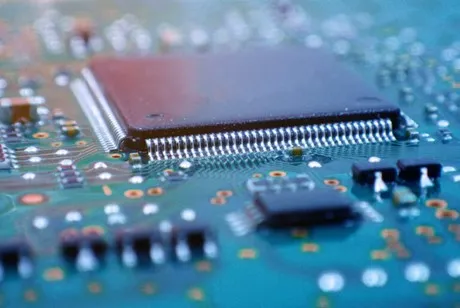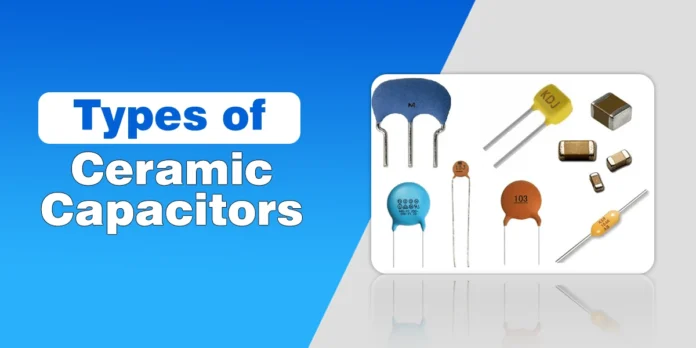Ceramic capacitors are widely used in electronic circuits due to their reliability, small size, and cost-effectiveness. They are non-polarized, meaning they can be connected in any direction in a circuit.
Their ability to provide reliable performance in a compact form factor makes them indispensable in a wide range of applications.
In this article, I will look at the types of Ceramic Capacitors, their advantages, and how to use them.
Ceramic Capacitors Explained
A ceramic capacitor is made from ceramic material and usually consists of two electrodes separated by a disc, a dielectric material that is used for various electronic applications. They are small and lightweight but can store large amounts of energy.
They also have excellent stability, are sold at affordable prices, and have high insulation resistance.
Common Types of Ceramic Capacitors
Semiconductor Ceramic Capacitors
Capacitor microminiaturization is the capacitor in the smallest volume obtained from a large capacity, which is among the trends in capacitor development. For the capacitor components separation, miniaturization is done in two basic ways regardless of whether the dielectric material’s dielectric constant is high and makes the dielectric layer thickness thin.
When it comes to these materials, ferroelectrics contain high dielectric constants, but it’s hard to make them thin while ordinary ferroelectric capacitors are made with ferroelectric ceramic. Firstly, ferroelectric has low strength, it’s thin and easily breakable, making it difficult to execute the actual production operation. Additionally, the thin features of the dielectric material result in various organizational defects, making the production process difficult.
The surface layer of the material utilizes a thin insulating layer created on the semiconductor ceramics surface like BaTiO3 as the dielectric layer, and the semiconductor is considered a series of dielectric circuits. The insulating surface layer thickness of the surface layer ceramic capacitors usually fluctuates between 0.01 and 100 μm based on the method of formation and conditions. This process utilizes high ferroelectric ceramics dielectric constant and efficiency thins the dielectric layer thickness which is used to prepare micro and small ceramic capacitors.
Grain Boundary Layer Ceramic Capacitors

The BaTiO3 semiconductor surface with a fully developed form coated with the right metal oxide such as CuO or Cu2O, MnO2, Bi2O3, Tl2O3, and other related and treated with heat under oxidation conditions at the right temperature as well. The thin solid solution insulating layer is created on the grain boundaries, which has high resistivity of up to 1012-1013 Ω-cm and while the grain interior is also semiconductor, the entire ceramic body acts like an insulator medium having a visible dielectric constant of 2 × 104 to 8 × 104. The capacitor made from his porcelain is known as the grain boundary layer ceramic capacitor, also called BL capacitor.
High-Voltage Ceramic Capacitor
With the increasing advancement in the electronic industries, the need for high breakdown voltage, low loss, small size, and high voltage capacitors is always increasing. In past years, these capacitors were developed successfully at home and internationally and used in electric power systems, laser power supplies, tape recorders, TVs, copiers, and many other smart home electrical appliances.
This high voltage is made from barium titanate-based non-metal materials that possess the benefits of high dielectric coefficient and good alternative current voltage characteristics but have some downsides in terms of capacitance change rate when the dielectric temperature and insulation resistance decline.
The strontium titanate crystal cutie temperature is around -250°C, and it’s a cubic crystal system chalcogenide that is structured at room temperature and is para electric and doesn’t have spontaneous polarization features. The dielectric coefficient change of the strontium titanate-based ceramic material is usually low under high voltage, which makes it beneficial for usage.
Read here: https://www.reddit.com/r/AskElectronics/ to gain more insight into ceramic capacitor voltage ratings.
Multilayer Ceramic Capacitors
MLCC is the most popular utilized chip component type; it’s the inner electrode material, and the non-metal blanks are placed in parallel with alternate layers and turn into a whole, also called chip monolithic capacitors. It has small size, high specific capacitance, and precision, and can be placed on printed circuit boards, hybrid integrated circuits, and many more.
Additionally, it can effectively decrease the size and weight of electronic information terminal products especially portable items and enhance product reliability. It’s similar to the development direction of miniaturization, lightweight, and functions of the IT field.
What Are the Advantages of Ceramic Capacitors?
There aremany advantages of ceramic capacitors, including:
- They are reliable and have great frequency response features when running at higher frequencies.
- They can handle high voltages of over 100volts.
- They are lightweight, even lighter than other types of capacitors.
- They are sold at an affordable price compared to other capacitors.
- They come in different shapes and sizes to choose from
- They have low effective series resistance and lower effective series inductance than other capacitor types.
What Are Ceramics Capacitors Used For?
These non-metal products are primarily used for high-stability performance and low-loss devices. They provide accurate results and the capacitance value of the capacitors and are stable with respect to the voltage, frequency, and temperature that was applied.
You can check a capacitor using a multimeter by first turning the multimeter to the lowest resistance setting, then connecting one lead of the multimeter to one lead of the capacitor and the other leads of the multimeter to the other lead of the capacitor. You will see the reading close to zero ohms; if it’s higher than that, it’s likely the capacitor has spoilt and needs to be replaced.
Conclusion
Ceramic capacitors are of different types, including the semiconductor, grain boundary layer, and multilayer. It has many advantages, including having great frequency response, being lightweight compared to others, coming in different sizes and shapes, so you get to choose one that will suit your needs, being sold at a more affordable price than other types, being able to handle up to 100 volts, and many more.
Overall, these products used high stability performance and low loss devices and provide accurate results that are close to zero. Any number that is higher than this is an indication that the device is damaged and needs to be replaced.

